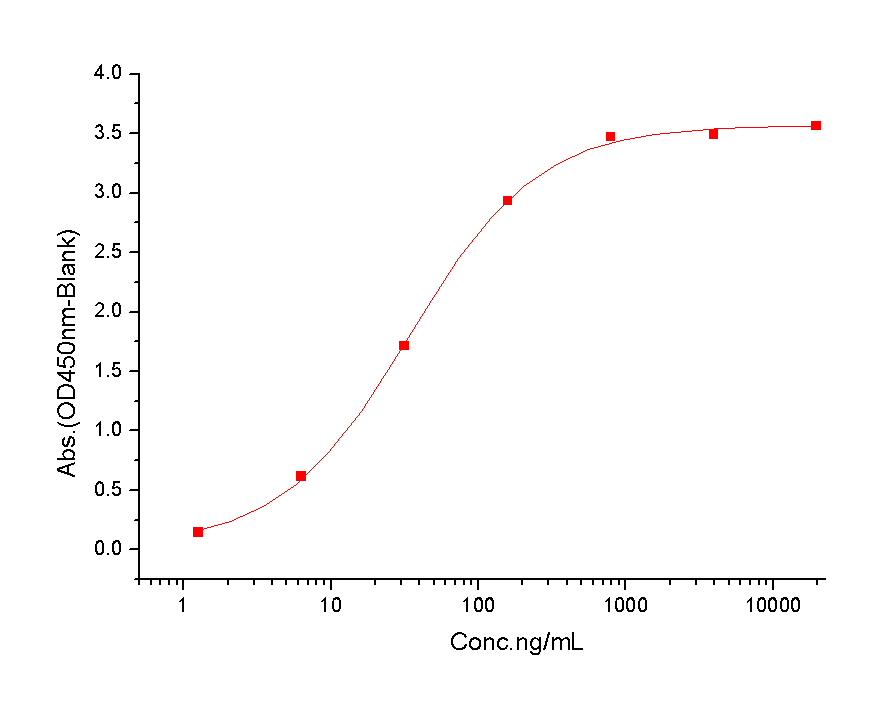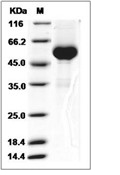购物车
- 全部删除
 您的购物车当前为空
您的购物车当前为空

RANKL/TNFSF11/CD254 Protein, Human, Recombinant (mFc) is expressed in HEK293 mammalian cells with mFc tag. The predicted molecular weight is 52.4 kDa and the accession number is AAC51762.1.

| 规格 | 价格 | 库存 | 数量 |
|---|---|---|---|
| 100 μg | ¥ 3,930 | 现货 | |
| 200 μg | ¥ 6,720 | 5日内发货 | |
| 500 μg | ¥ 13,590 | 5日内发货 |
| 生物活性 | 1.Measured by its binding ability in a functional ELISA. Immobilized Human TNFRSF11B His at 2 μg/ml (100 μl/well) can bind Human RANKL mFc, the EC50 of Human RANKL mFc is 15-80 ng/mL.
2. The bioactivity of hRANKL was determined by measuring the ability of hRANKL to induce TRAP activity in Raw 264.7 cells. The ED50 for this effect is typically 15-45 ng/mL.  |
| 产品描述 | RANKL/TNFSF11/CD254 Protein, Human, Recombinant (mFc) is expressed in HEK293 mammalian cells with mFc tag. The predicted molecular weight is 52.4 kDa and the accession number is AAC51762.1. |
| 种属 | Human |
| 表达系统 | HEK293 Cells |
| 标签 | N-mFc |
| 蛋白编号 | AAC51762.1 |
| 别名 | tumor necrosis factor (ligand) superfamily, member 11,TRANCE,TNFSF11,sOdf,RANKL,OPTB2,OPGL,ODF,hRANKL2,CD254 |
| 蛋白构建 | A DNA sequence encoding the human TNFSF11 (AAC51762.1) (Gly63-Asp244) was expressed with the Fc region of mouse IgG1 at the N-terminus. Predicted N terminal: Asp |
| 蛋白纯度 | > 90 % as determined by SDS-PAGE  |
| 分子量 | 52.4 kDa (predicted); 50-60 kDa (reducing condition, due to glycosylation) |
| 内毒素 | < 1.0 EU/μg of the protein as determined by the LAL method. |
| 缓冲液 | Lyophilized from a solution filtered through a 0.22 μm filter, containing PBS, pH 7.4. Typically, a mixture containing 5% to 8% trehalose, mannitol, and 0.01% Tween 80 is incorporated as a protective agent before lyophilization. |
| 复溶方法 | A Certificate of Analysis (CoA) containing reconstitution instructions is included with the products. Please refer to the CoA for detailed information. |
| 存储 | It is recommended to store recombinant proteins at -20°C to -80°C for future use. Lyophilized powders can be stably stored for over 12 months, while liquid products can be stored for 6-12 months at -80°C. For reconstituted protein solutions, the solution can be stored at -20°C to -80°C for at least 3 months. Please avoid multiple freeze-thaw cycles and store products in aliquots. |
| 运输方式 | In general, Lyophilized powders are shipping with blue ice. |
| 研究背景 | Tumor necrosis factor ligand superfamily member 11, also known as Receptor activator of nuclear factor kappa-B ligand, Osteoprotegerin ligand, TNFSF11, RANKL, TRANCE, OPGL and CD254, is a single-pass type II membrane protein that belongs to the tumor necrosis factor family. The receptor activator of nuclear factor-kappaB ligand (RANKL), its cognate receptor RANK, and its natural decoy receptor osteoprotegerin have been identified as the final effector molecules of osteoclastic bone resorption. RANK and RANKL are key regulators of bone remodeling and regulate T cell/dendritic cell communications, and lymph node formation. Moreover, RANKL and RANK are expressed in mammary gland epithelial cells and control the development of a lactating mammary gland during pregnancy. Genetically, RANKL and RANK are essential for the development and activation of osteoclasts and bone loss in response to virtually all triggers tested. Inhibition of RANKL function via the natural decoy receptor osteoprotegerin (OPG, TNFRSF11B) prevents bone loss in postmenopausal osteoporosis and cancer metastases. Importantly, RANKL appears to be the pathogenetic principle that causes bone and cartilage destruction in arthritis. RANK-RANKL signaling not only activates a variety of downstream signaling pathways required for osteoclast development, but crosstalk with other signaling pathways also fine-tunes bone homeostasis both in normal physiology and disease. In addition, RANKL and RANK have essential roles in lymph node formation, establishment of the thymic microenvironment, and development of a lactating mammary gland during pregnancy.Cancer ImmunotherapyImmune CheckpointImmunotherapyTargeted Therapy |